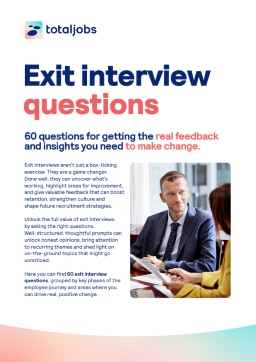
Exit interviews: What are they and why do they matter?
Table of Contents
- What is an exit interview?
- Conducting exit interviews
- Exit interview feedback
- Potential next steps
- FAQs

Exit Interview Toolkit
Finding and retaining talent is no easy task. In fact, our research shows that 64% of recruiters struggle to identify candidates with the right skills. Adding to the challenge, 1 in 3 UK workers plan to change jobs this year, with 72% of them citing salary as their top priority.
To navigate this landscape, it’s crucial for employers to understand why employees leave and how to keep them engaged. One of the most effective ways to gain these insights is through conducting exit interviews.
In this article, we’ll explore what exit interviews are, the key benefits they offer, and how to conduct them effectively.
What is an exit interview?
An exit interview is a structured discussion employers hold with employees leaving their organisation, usually conducted on their last day of work. While employees often give generic reasons for departure, exit interviews provide an opportunity to obtain deeper insights and understand what has driven them to move elsewhere.
These interviews can be conducted face-to-face, either with HR or an employees direct line manager. Alternatively, employers may choose to utilise written or online surveys.
Benefits of exit interviews
While not legally required, by conducting exit interviews employers can leverage significant benefits that can drive organisational improvements moving forward.
This includes:
- Enhanced understanding of employee perspectives: Exit interviews provide a unique opportunity to understand why employees are leaving, uncovering underlying issues that might not be immediately apparent. This is particularly crucial, with our research showing that 59% of businesses are facing increased competition to find talent with the right skills.
- Assessing manager performance and capability: These interviews can provide insights into how employees view their managers. Given that 52% of employees who resign believe their organisation could have done more to keep them, exit interviews can help identify areas where leadership might need improvement.
- Identifying positives and recurring issues: Exit interviews can highlight positive aspects, like a supportive culture, that you can build on, and reveal common problems leading to employee turnover, such as limited career progression opportunities. Addressing these patterns can help create a more appealing workplace.
- Parting on good terms: Exit interviews present an opportunity to leave on a positive note with departing employees. This can foster goodwill and even encourage “boomerang employees,” those who leave and later return. Considering that more than a quarter of new hires in some markets are boomerangs, this can be a clever strategy for attracting talent over the long term.
- Reducing staff turnover: With the UK worker turnover rate at 35%, reducing employee churn is critical, and exit interviews can provide insights into why staff leave and help facilitate retention. Since only 22% of employees feel engaged at work, understanding these dynamics through exit interviews can inform the necessary changes to lower turnover and boost engagement.
Who should conduct an exit interview?
Selecting the right person to conduct an exit interview is crucial for encouraging open and honest feedback.
Ideally, the interviewer should be someone with a neutral stance, ensuring that the departing employee feels comfortable expressing their views. This generally rules out the employee’s direct manager, as they might be a source of dissatisfaction or conflict, making it harder for the employee to speak candidly.
HR professionals are typically a good choice, as they can maintain neutrality and confidentiality. However, if the HR representative is one of the departing employee’s team members, it could lead to discomfort.

Tip: The key is to choose an interviewer who can create a safe environment for the employee to share their experiences and trust that their feedback will be handled with sensitivity and discretion.
Conducting effective exit interviews
When considering how to conduct an exit interview, employers should consider a structured approach that encourages open and honest feedback.
Here are 8 practical steps you can follow to help you get the most out of the process.
1. Invite employee to participate
Participation in exit interviews is not mandatory. As a result, it’s important to invite employees in a way that feels respectful and welcoming.
By emphasising that their contribution is valuable and that you want to hear from them, you increase the chances that they’ll agree to participate.
To create an atmosphere where employees feel comfortable sharing their thoughts, employers should reassure employees that their feedback will be kept confidential and that their comments won’t affect future references or relationships.
2. Offer flexible feedback options
Offering multiple feedback options can help encourage participation. While some employees might prefer a face-to-face meeting, others might feel more at ease with a phone call or an online survey. Giving employees a choice in how they provide feedback shows that you respect their preferences and can lead to more candid responses.
3. Schedule a suitable time frame
Timing is key to a successful exit interview. Schedule the meeting for a time that works best for the employee, often on their last day or during their notice period. Aim for a duration of about an hour, ensuring enough time to have a meaningful discussion without overwhelming the interviewee. Choosing the right time frame demonstrates that you value their input and respect their time. Remember:
- If the interview is too short, you might miss out on valuable insights.
- If the interview is too long, it could feel like an unnecessary burden.
Striking the right balance helps create a positive experience for both parties.
4. Collect preliminary information
Before the interview, it can be useful to collect preliminary information to guide the conversation. This can involve asking employees to complete a brief survey or questionnaire that covers key topics such as:
- Job satisfaction
- Workplace culture
- Management
- Their reasons for leaving
This initial data helps focus the interview and ensures the interviewers can cover important issues and tailor questions to each employee’s specific situation, leading to a more productive and relevant conversation.
5. Prepare a structured question list
Preparing a structured list of questions can help ensure the interview is focused and productive, and make it easier to analyse the feedback later. Below we’ve outlined some exit interview questions that can assist in gathering meaningful insights during the offboarding process:
- What influenced you to seek employment elsewhere? This question can uncover the primary reasons behind the employee’s decision to leave.
- What could we have done to prevent you from leaving? This question identifies potential interventions that could have retained the employee, offering insight into areas for improvement.
- What does the job you are going to offer that your job here did not? This question allows you to compare your organisation with competitors and find areas where you can strengthen your employee value proposition.
- What did you most enjoy about working here? By focusing on positive aspects of the employee experience, this question helps identify what your organisation does well, allowing you to reinforce these strengths.
- Is there anything you didn’t like about working here? This question uncovers areas of dissatisfaction, highlighting issues that might need addressing.
- What could your manager have done better? This question facilitates assessment of the effectiveness of management and helps identify opportunities for leadership development.
- How would you describe (and how do you feel about) our culture? This question offers an opportunity to gather feedback on workplace culture and understand how it’s perceived by departing employees.
6. Provide questions in advance
Sending the list of pre-prepared questions to the employee ahead of time allows them to think about their responses prior to the interview. This can also help them feel more at ease during the conversation, leading to more honest and detailed feedback.
7. Choose a private setting
A quiet, enclosed space without distractions is ideal for exit interviews. This ensures that the employee feels secure and can speak openly without worrying about being overheard or judged by others.
A private setting also helps establish the tone of the interview. When employees feel that their conversation is truly confidential, they’re more likely to share honest feedback and discuss sensitive topics.
8. Ensure confidential feedback storage
Maintaining confidentiality in exit interviews is crucial for encouraging honest and constructive feedback.
Employers should prioritise keeping the employee’s identity anonymous when sharing their feedback with others in the organisation. This can be challenging, especially in smaller organisations where it’s easier to deduce who provided the feedback. A practical workaround is to present exit interview feedback in aggregate form, combining it with other data sources like 360-degree surveys. This approach helps to maintain anonymity while still making it possible to extract valuable insights from the feedback.
Additionally, it’s essential to store all records from exit interviews securely. Remember, only those with a legitimate need should have access to this information.
Exit interview feedback
Exit interview feedback can offer valuable insights, but it must be shared thoughtfully to protect anonymity. What you want to achieve from the feedback will determine who you share it with. This might include, for example:
- HR: HR should receive the complete exit interview information as it’s their responsibility to identify trends and highlight areas that may need investigation. By having access to feedback, HR can create organised reports and visual representations that allow them to track issues over time.
- Management: While sharing feedback with management, employers should be careful to maintain confidentiality and address sensitive topics discreetly. It’s best to share any feedback related to specific managers in a private setting, focusing on constructive discussions.
- Individuals: If individuals are mentioned during exit interviews, it might be appropriate to share this in a private, one-on-one setting that allows for an open discussion. Employers should use discretion when deciding whether to share this feedback, ensuring it’s constructive and focused on improvement.
- The wider organisation: To keep the broader organisation informed, consider sharing regular updates about general trends in feedback and how the organisation is addressing them. This can be done through quarterly emails or meetings, highlighting changes made based on exit interviews and other feedback channels.
Potential next steps
Feedback from exit interviews is an invaluable resource for creating a better working environment. Here are some next steps for employers to consider after the exit interview process is complete:
- After analysing exit interview feedback, identify areas where additional training might be needed. This could involve skill development or leadership training to address gaps and improve employee satisfaction.
- If feedback indicates structural issues, consider reorganising teams or redefining roles to improve workflow and communication.
- If exit interviews reveal compensation concerns, reviewing and adjusting salary and benefit offerings may help retain talent moving forward.
- Feedback from exit interviews might point to cultural issues, providing an opportunity to re-evaluate and redefine organisational culture to foster a more inclusive, respectful, and engaging environment.
- If a lack of career growth is a recurring theme, providing transparent career paths and succession planning can boost retention and increase motivation.
- In some cases, exit interview feedback may require deeper investigation. Whether it’s an HR-led review or an external audit, further investigation can help resolve underlying issues.
Frequently asked questions (FAQs)
Who should conduct an exit interview?
Ideally, a neutral party such as someone from HR should lead the interview. This helps the departing employee feel comfortable sharing candid feedback, without concern that it will affect relationships with their direct manager.
When should you conduct an exit interview?
The best time is during the employee’s notice period, ideally in their final week. This ensures their experience is still fresh in their mind while allowing them to speak openly, knowing their departure is already confirmed.
What format should an exit interview take?
You can conduct it in person, over the phone, or via a video call. While written questionnaires can work, a live conversation often produces richer and more detailed insights.
How should you prepare for an exit interview?
Have a clear set of questions prepared in advance, covering areas such as job satisfaction, reasons for leaving, company culture, and management style. Creating a calm, private environment will help the employee feel at ease.
How can you make an exit interview effective?
Listen actively, avoid becoming defensive, and make it clear that all feedback is valued. Take thorough notes, assure confidentiality, and focus on trends rather than singling out individuals when sharing findings.
Explore articles
Receive the latest recruitment resources and
advice to boost your hiring
By providing us with your details you agree to our privacy policy and for us to keep you updated with the latest news, events,
and special offers from Totaljobs.







